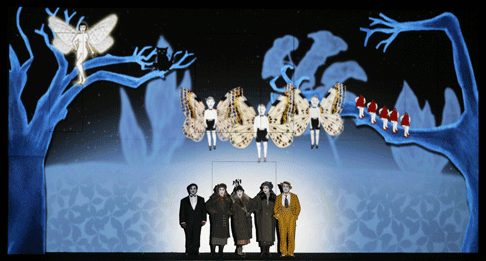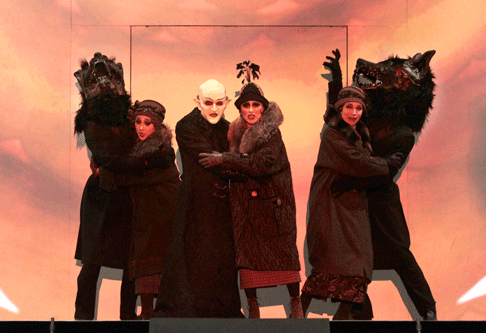Los Angeles Opera's new production of Wolfgang Amadeus Mozart's The Magic Flute opened on November 23, 2013. Brought here from the Komische Oper in Berlin where it premiered last year, the production is a multimedia rendition in the style of the British theater group 1927. The concept by Suzanne Andrade, Paul Barritt, and Barrie Kosky combines opera with 1927's silent movie technique to produce a 'film noir' ambience. Throughout the evening singers interacted with the hand-drawn animation projected onto the screen to evoke the style of silent film. The use of projections instead of stick-built scenery is a growing trend among opera companies since it saves a good deal of time and money that can be used elsewhere.
Although designer Esther Bialas had to deal with the lighting from the projections, she made the singers look like their characters as they acted out the story in front of screens. Silent-film pictures with minimalist texts above Buster Keaton-styled images appeared during the opera's recitatives. Pianist Tamara Sanikidze accompanied them on an eighteenth century hammerklavier with music from Mozart's fantasias K 397 in D minor and K 475 in C minor. Her artistry was magnificent and the extra music provided an unexpected treasure.
 Tamino (Lawrence Brownlee, at left) and Papageno (Rodion Pogossov, at right) are sent by the Three Ladies (Hae Ji Chang, Cassandra Zoe Velasco, Peabody Southwell) to rescue Pamina.
Tamino (Lawrence Brownlee, at left) and Papageno (Rodion Pogossov, at right) are sent by the Three Ladies (Hae Ji Chang, Cassandra Zoe Velasco, Peabody Southwell) to rescue Pamina.
The projected video sometimes involved nearly one thousand layers that had to be manually triggered by the stage manager so that the animation matched the conductor's tempi. Los Angeles Opera Music Director James Conlon called the concept 'an extraordinary idea and an extraordinary execution of that idea', adding that 'for LA, the birthplace of movies, it's a perfect fit'. Barrie Kosky said that the rhythm of the music and the text had an enormous influence on the animation. He and his collaborators condensed the dialogues and transformed them into silent film 'intertitles' with piano accompaniment.
After a rousing rendition of the opera's overture, the voice of Lawrence Brownlee as Tamino resonated throughout the hall as he fought a huge dragon that wanted to devour him. He sang this aria and the rest of the role with beautifully cultivated tone. The Three Ladies who really did slay the monster were Hae Ji Chang, Cassandra Zoé Velasco, and Peabody Southwell. Chang's radiant, lustrous soprano was particularly well focused. Velasco provided sumptuous harmony, but Southwell's low notes could have been stronger. Evan Boyer, the Sarastro, is a very young bass with a pleasant voice but his low tones could have been more robust. As the Queen of the Night, Erika Miklósa negotiated her phenomenally difficult arias without missing the tiniest note. Most coloratura sopranos don't sing the Queen for very long, but she has sung it for more than four hundred performances.
 Thrown out of Sarastro's temple, Monostatos (Rodell Rosel) teams up with the Queen of the Night's Three Ladies (left to right: Hae Ji Chang, Cassandra Zoe Velasco, Peabody Southwell).
Thrown out of Sarastro's temple, Monostatos (Rodell Rosel) teams up with the Queen of the Night's Three Ladies (left to right: Hae Ji Chang, Cassandra Zoe Velasco, Peabody Southwell).
Dressed as Nosferatu, Rodell Rosel portrayed an evil Monostatos whose amusing aria did not win him much sympathy. The tenor voice of Vladimir Dmitruk, the First Armed Man, made listeners wonder when he will sing a larger part. Philip Addis was a stentorian speaker and Valentin Anikin a secure Second Armed Man. Amanda Woodbury was a charmingly sexy Papagena and the three boys from the LA Opera Children's Chorus added a piquant note to the mix. Grant Gershon's adult chorus sang with stirring harmony in their hand-drawn, animated state. Conductor James Conlon, who regaled the audience with a delightful pre-show lecture, had a little difficulty synchronizing stage and pit in the first moments after the overture. After that, he conducted with delightfully varied tempi and rubato that brought out the lilting qualities of Mozart's music. Premieres are always fun at Los Angeles Opera and this one was the cream of the crop.
Maria Nockin
Cast and production information:
Tamino, Lawrence Brownlee; Pamina, Janai Brugger; The Queen of the Night, Erika Miklosa; Sarastro, Evan Boyer; Papageno, Rodion Pogossov; First Lady, Hae Ji Chang; Second Lady, Cassandra Zoé Velasco; Third Lady, Peabody Southwell; Monostatos, Rodell Rosel; Papagena, Amanda Woodbury; The Speaker, Phillip Addis; First Armored Man, Vladimir Dmitruk; Second Armored Man, Valentin Anikin; First Boy, Drew Pickett; Second Boy, Charles Connon; Third Boy, Jamal Jaffer; Conductor, James Conlon; Directors, Suzanne Andrade and Barrie Kosky; Animation, Paul Barritt; Concept 1927 (Suzanne Andrade and Paul Barritt) and Barrie Kosky; Scenery and Costume Designer, Esther Bialas.


